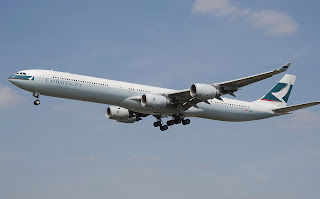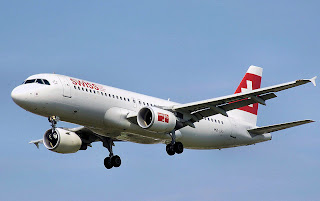A380-800
The A380-800 is the largest commercial airliner in service and is easy to spot, although currently I believe the only airport in the U.S. where you can see them is LAX, since Quantas uses one on its Sydney-Los Angeles route. These are rare, since they have only been in production for a few years, take a lllonnngg time to manufacture, and are very expensive, normally keeping them out of the hands of the non-subsidized American carriers. How do you recognize it? Its the only full length double decker airliner in the world, its huge, and it has the big (ugly) forehead above the cockpit (unlike the 747 which has its cockpit on the second level). I saw this plane close up at the Paris Airshow and at DeGualle Airport and they are huge airplanes (they can hold over 800 people in high-density configuration!).
A340-200,-300,-500,-600
The variants aren't that important here, as they just involve newer components, higher MTOWs, longer ranges, and longer fuselages. This one is also easy: its the only four engine, singe decked widebody (besides the now extremely rare DC-8 that I may cover in another post). It is also extremely long (with the A340-600 currently holding the record for longest airliner, although the B747-800 will surpass it once its delivered hopefully later this year). The A340 has designed for long range in the late 1980s, with its competitor being the B777, which is a far more innovative and successful aircraft. If you wish to know what are the reasons behind the designs of the A340, B777, and A330, as well as why you will spot B777s taking off from Logan but not A340s, just let me know and I can make it the subject of another post.
A330-200,-300
The A330 was designed right after the A340 and they both feature a common fuselage and wing structure. Obviously, the big differences between the two aircraft are that the A330 is shorter and has only 2 engines. This one is a pain to figure out, considering it has common features with both the B767 and B777. Just for knowledges sake, the A330 is intended in both range and capacity to compete with the B767. In fact, I'll be honest and say that until I made this post, I had no idea how to tell the difference between the B767 and the A330. They both have similar engines, landing gear configurations, and fuselages. The A330 is slightly larger, but this can be hard to notice at a distance. First, the B767 has a more blunted nose than the A330. The only other "easily" recognizable difference is where the tail meets the fuselage in the front. Instead of meeting the fuselage at a sharp angle on both aircraft, the tail structure tapers forward a little bit. There are too differences between the taper on the A330 and B767. The A330s is more pronounced, i.e. larger, than the B767s. The A330s also begins to taper off at a harder angle than the B767, which has a curved taper. Heres a picture of the B767 to demonstrate:
Although in the pictures the differences may seem obvious, when actually plane spotting its very difficult to tell. The similarity between the A330s and B777s nose shapes don't help either.
A320, A318, A19, A321
Okay, this plane is a pain in the ass only because as you may have noticed, instead of making small variants (like A320-100,-200,-300), Airbus made larger variations that are their own types. But the A320 is the original aircraft and by far the most widespread. The A320 is designed to compete with the B737 in the short-haul market, and is second only to the B737 in airliner sales of any type (yeah Boeing!). The A320 is actually quite easy to spot when compared to the B737, since the nose below the cockpit juts out distinctively and has a different cockpit window style to the B737, which you can see in the B737 photo in the previous post. Also, whereas the B737 is like a rotund corgie, the A320 is like a wiener dog. If you've taking a Jetblue flight greater than Roch-JFK or Roch-Logan, then chances are you've ridden a A320. Part of the reason Jetblue is such a successful low-cost carrier is because they only use two types of aircraft, the A320 and the Embraer ERJ-190, greatly lowering maintenance and training costs. Now, there is no point in trying to tell the difference between the A320,-18,-19,-21. But once again just to know, the numbers are relevant to length of the fuselage, i.e. capacity. The A318 is the smallest variant and the A321 is the largest. Not only are the size differences very small, but the appearances of and technology within the variants are virtually identical.
A300B1,-B2,-B4,-600, A310
The A300 is the first Airbus production model and dates back to the early 1970s. As a result, most of them have been retired, especially within the U.S., due to its outdated avionics and poor fuel consumption. This aircraft is famous for being the first twin engine widebody airliner, a market that Boeing jumped on and eventually dominated with the B767 and B777. You can tell it apart from any Boeings using the same characteristics as the A330. The challenge is how the hell to tell it apart from the A330. The A330 incorporated design features of the A300, as they both were targeted at the same niche. Since most of the active A300s have updated engines, you can't really tell between the two using the turbofans. Furthermore, the A330 is less than 10 meters longer than the A300. Instead of trying to find a tiny difference between them, I'll just help you tell the difference using context. The A300 is an old aircraft that has not been updated in many years by Airbus (unlike the older B747). In turn, usually only second-rate carriers that lease older, used aircraft operate them. The A330, on the other hand, is a modern aircraft that has been kept up with recent technological innovations. A330s are "widely" operated, used by carriers such as Delta (I used the ""s because as in all classes, Boeing aircraft are most widely used, if only by a small margin). In fact, one of Delta's A330s was the plane flying from Amsterdam to Detroit when the attempted Christmas bombing occurred last year. Finally, as for the variants, the A300B1 was the test version, the A300B2 was the initial production version, and A300B4 was the most produced model, and the A300-600 was a greatly upgraded version that eliminated the need for a flight engineer. Finally, the A310 is just a shortened version of the A300B4.
Yay! We've finished the Airbuses. The remaining aircraft are the Bombardiers, Embraers, and McDonnell-Douglases, which as there are few types, I can cover in one post. Perhaps one day I can also do a vintage aircraft edition, but probably not for a while.








